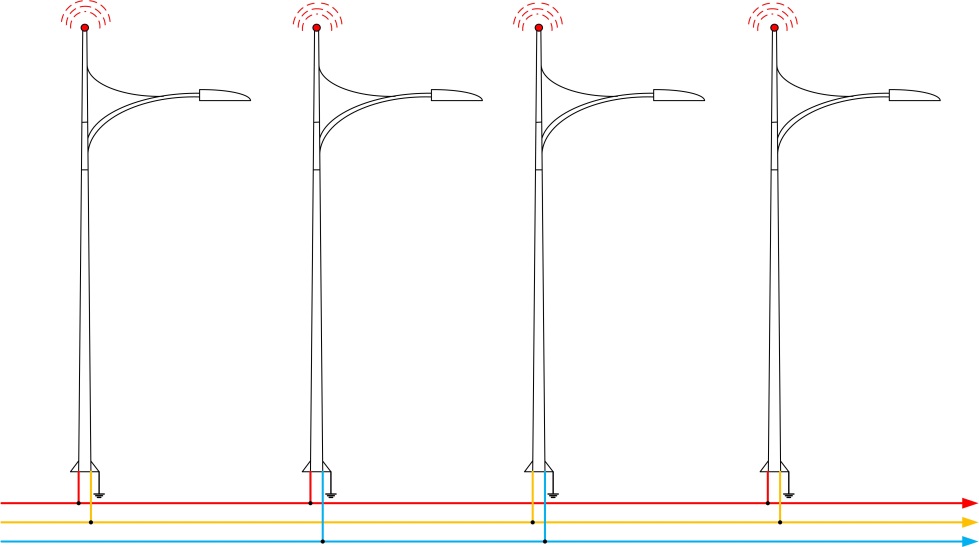【Introduction】There are many wide input voltage AC/DC power supplies on the market. Since the power supply with an input range of 90-305VAC covers nominal voltages of 100, 115, 230 and 277Vac, it can be used as a universal voltage. However, many industries install three-phase power without a neutral, so a wider input voltage range is required to meet the phase-to-phase input requirements. This article will explain why a new low power AC/DC converter with a 6:1 input voltage range was developed.
First a brief technical note: In a three-phase mains supply, the phases form a 120° angle to each other. The phase-to-phase voltage is shown in Figure 1. The magnitude of VAB is √3 times the single-phase voltage VA.

Figure 1: Three-phase power supply vector diagram

In some industrial applications, AC power is rectified to produce unsmoothed DC power. All standard AC/DC converters work fine as long as the DC voltage is within the input voltage range. The root mean square (rms) AC voltage is defined as the thermal effect of the AC voltage on a purely resistive load equal to the DC voltage. In fact, the peak-to-peak AC voltage is much higher than the rms voltage (Figure 2). If the mains supply is full-wave rectified, the resulting DC voltage will be √2 times higher than the nominal rms voltage. Therefore, to cover all possible rectified three-phase AC input voltages, the DC input voltage range of the converter must be at least as high as 678VDC.

Figure 2: Full-wave rectified AC waveform

In order to meet the AC voltage of single-phase and opposite-phase, as well as the voltage requirements after full-wave rectification.
RECOM Power has launched the RAC05-K/480 series, which has an ultra-wide input AC voltage range of 85-528VAC, and a DC input voltage range of 120V to 745VDC, so this series can meet 100V to 480VAC or rectified DC input voltage. There are three main application areas for ultra-wide input voltage AC/DC converters: condition-based maintenance (CBM), smart street lighting, and phase-missing fault-tolerant industrial systems.
Maintenance based on status
Simply put, CBM means: “If it’s not broken, there’s no need to fix it!” The concept is continuous monitoring of machines and systems, and if all readings are within tolerance, there is no need to do any preventative maintenance. Only when the indicator starts to show new changes will it be investigated (for example: unexpected temperature increase, changes in the vibration characteristics of the motor, or abnormal data) and repaired if necessary.
CBM is used for intelligent maintenance systems (prediction and prevention rather than failure and repair), especially helpful for critical systems that can cause serious problems in the event of a shutdown, or for very large plants, the use of CBM can significantly reduce spare parts inventory and reduce operations Cost of maintenance department (each engineer can be responsible for more machines).
Like all information systems, regular data communication is required between CBM and the monitored equipment. If we take a motor health monitoring system as an example, sensors measure temperature, vibration, noise, rotational speed and supply current to get an accurate picture of motor performance. This information can be sent continuously by the wired fieldbus system or aperiodically after preprocessing over the wireless IoT link to reduce data traffic. In either case, a stable and reliable low-voltage DC power supply is required for the CBM monitoring system. Figure 3 shows that such a system has no neutral available and is therefore powered by two of the three phases.

Figure 3: The motor health monitoring system is powered by two phases of the three-phase motor power supply
Similar phase-to-phase AC/DC power is required in three-phase energy metering, electric vehicle charging stations, and sustainable energy monitoring and control systems.
Smart Street Lighting
The second most common application for low power 380-480V AC/DC converters is smart street lighting. The most common practice is that a low-power AC/DC power supply is installed on the lamp post of the street lamp, and the street lamp is connected to two phases of the three-phase electricity. The load on the three phases can thus be distributed equally while reducing the amount of wiring required. Each lamp post is grounded separately, so no additional ground or neutral wire is required.

Figure 4: Typical Wiring Diagram for Smart Street Lighting – Two Phases per Light
Streetlight control can be centrally coordinated using wireless or powerline communications, allowing streetlights to be automated (a GPS receiver can be installed on each lamp post, so each light knows its location, time, and sunrise and sunset times (civil twilight) , and transmitted as GPS astronomical data). In some lighting plans, such as multi-storey car parks, street lighting, and large-area lighting, motion detectors and vehicle detectors can also be included to turn street lights on where lighting is needed.
Whether the control is local or centralized, the sensors and communication transceivers must be powered by the phase-to-phase power supply. Their power requirements are not high, usually 3-4W is enough to power an IR detector, GPS module or mesh radio. The main problem with sensitive sensors or radios powered by high voltage electricity is how to deal with surges and transients. Outdoor smart light fixtures are generally classified as overvoltage category (OVC) III or IV, which means that voltage surges can be very high in energy because higher OVC categories have lower source impedances.

Figure 5: Overvoltage category
The RAC05-K/480 is OVC III compliant (built-in gas discharge tube, fuse and MOV). Installation of OVC IV requires a pre-filter consisting of an external surge arrester, which can be replaced after several surges of voltage or current as required by regulations.
fault tolerance
It is estimated that nearly 90% of power failures are caused by single-phase short circuits. Three-phase faults are extremely rare. In industrial applications the continuity of electrical power is extremely important for continuous operation or safety, so consider the use of ungrounded installations.
This is especially effective for delta power distribution systems, rather than the star configuration shown in Figure 1. The delta configuration can be ungrounded, corner grounded, or center tap grounded, using a high impedance ground or a fixed ground when grounding. The reason for this arrangement is that a ground fault may generate unwanted current in some parts of the system, but the rest of the system will still function normally. Therefore, although star connections are the most common, delta connections are still used in many critical processes, such as continuous production plants such as data centers, car factories or paper mills.
The RAC05-xxk/480 does not require grounding because it is a 4kVAC double isolated Class II device, so it is compatible with delta or star connections. It can also be used with a three-phase rectifier to become a phase-redundant power supply, as shown in Figure 2. If any single phase fails, the power can be supplied by the other two phases.

Figure 6: Connection selection of RAC05-xxK/480
in conclusion
The RAC05-K/480 series is a versatile AC/DC power supply that can be used in single-phase or phase-to-phase applications from 85VAC to 528VAC. Without any external components, the converter’s OVC III surge capability means it is suitable for a variety of industrial applications such as smart industry, smart lighting, and fault-tolerant industries.
RAC05-K/480 link: https://www.recom-power.com/pdf/Powerline_AC-DC/RAC05-K_480.pdf
More featured content: https://recom-power.com/rec-n-5-watt-ac!sdc-modules-for-wide-mains-voltages-up-to-480vac-30.htm
The Links: LP150X09-B5K8 VUO62-12NO7

0 Comments for “Auxiliary power supply for single-phase as well as phase-to-phase applications”